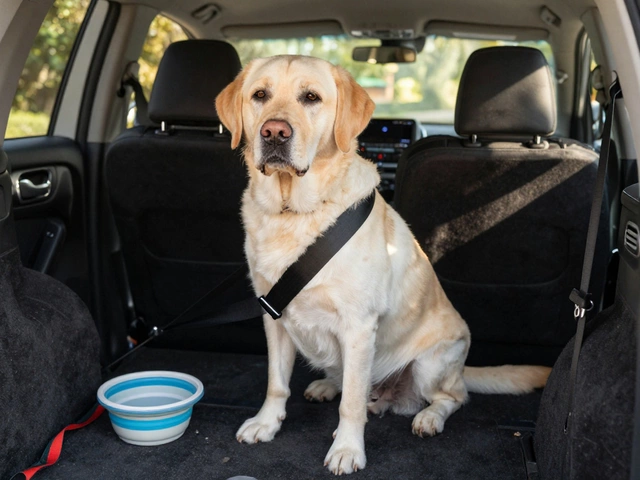You pack your beach bag, throw on sunscreen, grab your towel—then here comes your pup, tail wagging, ready to leap into the backseat. But wait, are dogs even allowed at the National Seashore you’re dreaming about? You’d be surprised how many folks turn up at the gate with their best friend, only to be sent packing or fined. As someone who’s adventured with a high-energy Australian shepherd, I’ll say: dog-friendly doesn’t mean rules-free. These shores are shaped by tide charts, nesting birds, and federal protection, not just paw prints in the sand. So before you promise your furry buddy a seaside spree, let’s get real about what National Seashores allow and what you need to know.
Which National Seashores Welcome Dogs?
National Seashores are different from your typical city or state beach. These are federally managed—pristine, wild, and fiercely protected—and that means regulations are tight. Across the U.S., there are ten major National Seashores, stretching from Cape Cod to the Gulf of Mexico. Not all of them love dogs equally. Some roll out the sandy carpet, others post big “no pets” warnings.
Here’s the quick rundown—the most iconic ones that allow dogs in some areas include:
- Cape Cod National Seashore (Massachusetts)
- Cape Hatteras National Seashore (North Carolina)
- Cape Lookout National Seashore (North Carolina)
- Cumberland Island National Seashore (Georgia, but with heavy restrictions)
- Gulf Islands National Seashore (Florida, Mississippi—very selective)
- Padre Island National Seashore (Texas)
On paper, places like Cape Cod look like a dog owner’s dream—miles of dune-backed beaches and salty air. But each seashore, even each section of shoreline, will write its own rules. For example, during piping plover nesting season (usually April through August), entire stretches go “no-dogs” overnight. On Cumberland Island, pets are allowed only on the public ferry and cannot set paw on boardwalks or in the backcountry. Gulf Islands bans pups from all Mississippi beaches—only one small area in Florida is approved, and you need to bring proof of vaccinations.
If you ever want to see how complicated this can get, check the table below for common dog rules at various National Seashores:
| National Seashore | Are Dogs Allowed? | Key Restrictions |
|---|---|---|
| Cape Cod | Yes, with exceptions | No dogs on lifeguarded beaches in summer, closed areas during nesting |
| Cape Hatteras | Yes | Leash required, some closures in spring/summer |
| Padre Island | Yes | Leash required, no dogs in buildings |
| Cumberland Island | Yes, very limited | No dogs in wilderness, ferry, or boardwalks |
| Assateague Island | Partly (Maryland side) | No dogs on Virginia side; some beach areas only |
Point is: check the official site for each park on the exact day you’ll visit. Rangers update closures and restrictions constantly, so what was “okay” last week might not be when you show up.
The Reason Behind the Rules: Nature Needs a Break Too
It’s easy to get annoyed at a “No Dogs On Beach” sign—believe me, I’ve muttered a few choice words hauling Ethan and his board back to the lot after the ranger’s warning. Looks like empty sand, right? But most National Seashores shelter endangered birds, rare turtles, or plant life that can’t handle a chasing dog, no matter how friendly your labradoodle is.
Piping plovers are a good example. These tiny shorebirds nest right in the open sand, often camouflaged among shells. A pup’s nose or a single digging paw can destroy a nest or scare off mom for good. In the Gulf, Kemp’s ridley turtles crawl in at night to lay eggs above the tide line—super sensitive to disturbance. Just a simple chase or bark can disrupt an entire season’s hatchlings.
Another thing people don’t realize: what starts as one mess (dog poop left behind) snowballs into water pollution and health hazards, not to mention grumpy locals and stricter rules. Rangers say that in 2023, 68% of written citations handed to dog owners were for leash violations, and 21% involved uncleaned waste. One popular stretch at Cape Henlopen even closed to animals for months because owners ignored notices.
It’s not just wildlife, either—a panicked child, a grandmother with mobility issues, or a birdwatcher with that “once in a lifetime” camera shot can all be thrown off by a dog running loose. That’s why restrictions can look over-the-top to dog lovers. But remember, you’re sharing this wild place with creatures and people who need it untouched, even if just for a season or a morning walk.

How to Plan Your Trip: Packing, Prep, and What to Expect
Real talk? Bringing your pup to a National Seashore isn’t as simple as a local park stroll. But it’s not impossible—especially if you plan ahead. Most National Seashores that allow dogs require them to stay leashed at all times, often with leashes no longer than six feet. “Voice control” won’t cut it, and retractable leashes are usually frowned upon. Check your leash’s actual length before you go, not just by eye.
You'll want to bring stacking water bowls, a sun shade or beach umbrella for your dog, and plenty of poop bags (some parks require you to pack waste out, not just toss it in park trash cans). A cooling vest or bandana goes a long way—dog paws burn fast on hot sand, and there isn’t always natural shade. If the parking lot is far from the beach, wagons or sturdy backpacks can save your back and your sanity.
- Check the forecast for red tide, high heat, or storm warnings—some seashores close entire areas if it’s unsafe.
- Make sure your pet’s vaccinations and tags are up to date. Rangers check, especially on busy weekends.
- Consider dog-safe sunscreen, since a burned belly or snout happens faster than you think.
- If your dog is noise-sensitive, know that some National Seashores allow beach driving, off-road vehicles, or host loud ranger programs.
- Pack extra towels (one for your pup, one for your car) and consider a drying mat or seat cover.
- If your pup drinks salt water, stop them quick—it causes dehydration in minutes.
- Look up tide charts before you visit. Low tide usually means more sand to spread out, but also exposes shells and critters tempting for curious dogs.
Many regulars hit the beach early—before 9 AM, you’re likely to snag a quieter stretch, before midday crowds, hot sand, and official patrol rounds ramp up. If your dog is new to the ocean, keep them leashed while exploring the water. Even confident swimmers can get caught in rip currents, step on jellyfish, or swallow water they shouldn’t.
Pro-tip: I carry a laminated “dog rules” quick guide from each park’s website in my glovebox. That way, if someone challenges us or if the ranger has questions, we can point to the source. Rangers appreciate guests who know and follow the details.
What to Do—and What Not to Do—At the National Seashore With Your Dog
It’s easy to get swept up in sandy play, but the most important part of the day? Respect for others. That means dealing with your pet’s mess, keeping them close, and being aware of zone changes. Many seashores have color-coded flags or posted maps showing “pet-friendly” zones. If you spot a nesting area roped off, keep a respectful distance, and don’t assume an empty stretch is okay just because no one’s enforcing right now.
If your dog scares birds or sniffs at wildlife, it’s time to move on. Teach a “leave it” or “come” command before your visit—you don't want to be that person hauling their dachshund out of a pelican’s nest. Carry treats as distractions for any unexpected distractions, too.
Many seasoned seashore-goers make a routine of rest stops. Find a shady corner, offer clean drinking water, and give your pup a break from the hot sand. Rotate the leash to avoid tangling, and be mindful of shells or fishing debris—dogs’ paws get cut easily. Always check for ticks before heading back to your car, especially in dune grass or wooded walkways.
Some beaches have rinse stations—use them if available. Rinsing salt and sand off paws helps prevent itching and keeps your car from becoming a mobile dune. And if someone approaches who’s nervous about dogs, take it as a chance to show off your stellar control. There’s always a wide eyed kid who isn’t comfortable meeting your golden retriever, and that’s their right just as much as it's your day to explore.
Sure, it’s tempting to post a million photos of your beach buddy frolicking in the surf—just be ready for comments if the leash is missing or if there’s a nest in the background. Dog lovers are everywhere, but so are the wildlife defenders. Lead by example, and the National Seashores will (hopefully) keep their pet-friendly policies open for summers to come.
Enjoy the waves, the sunrise, and those salty whisker kisses. Just remember—you’re sharing. Your furry pal is lucky to be here, and these wild spaces deserve as much love and care as the pups who run on them.





